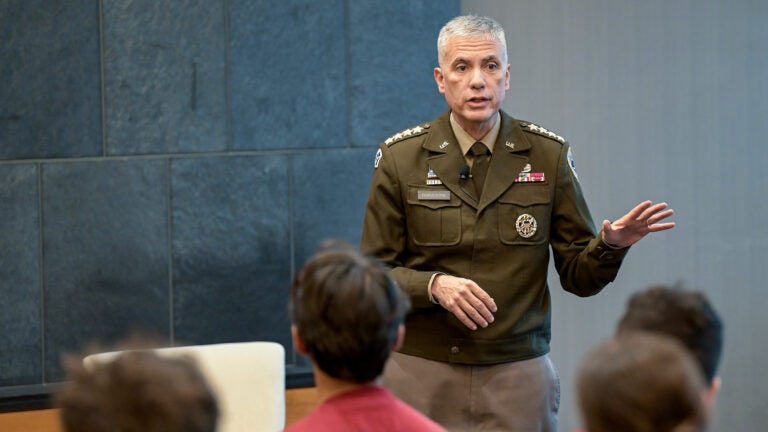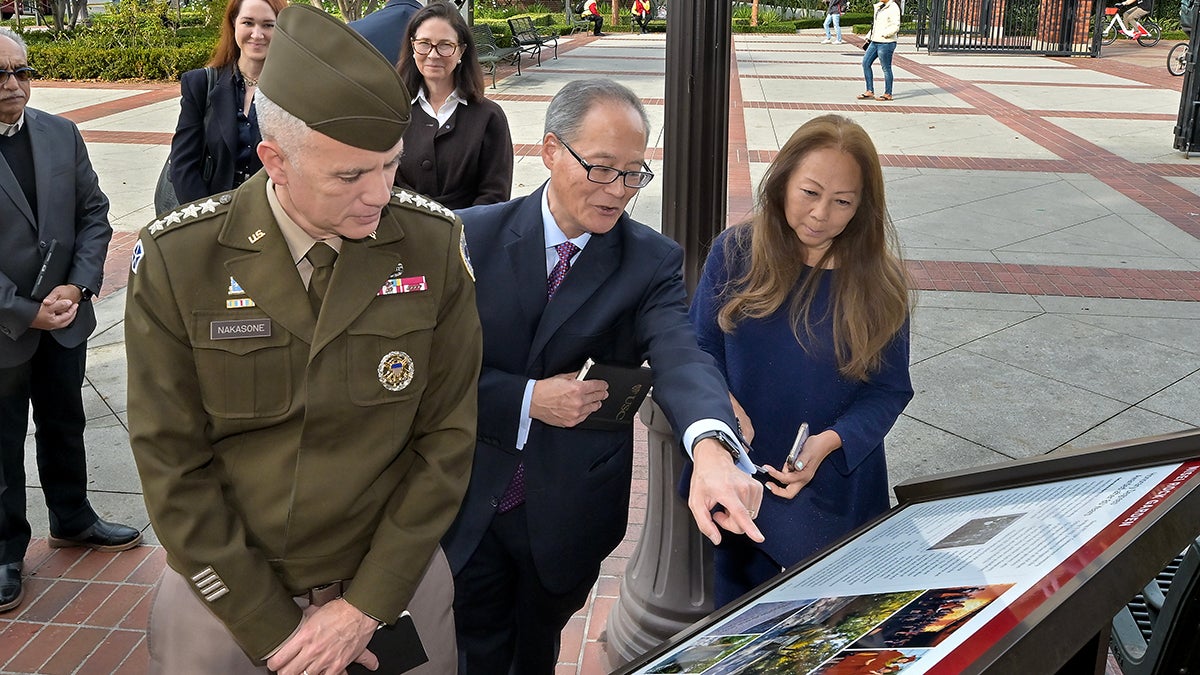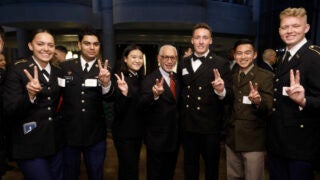
Gen. Paul Nakasone speaks at the Ronald Tutor Campus Center on Thursday. (USC Photo/Gus Ruelas)
NSA Director Gen. Paul Nakasone visits USC
The alumnus — commander of the U.S. Cyber Command and head of the National Security Agency — offered professional and personal advice to students, reflected on the past and shared hope for the future.
U.S. Army Gen. Paul Nakasone, the nation’s top military cybersecurity official and a USC alum, was contemplative as he read the inscription on a stone within the USC Japanese rock garden near Trousdale Parkway.
“On a stone for three years” is an ancient Japanese proverb that embodies resilience. It means that if one sits on a stone long enough, eventually it will become warm.
This symbol of perseverance honors the memory of the Japanese Americans — the Nisei — whose lives were upended by U.S. incarceration during World War II. The Nisei who had attended USC but were not allowed to finish were awarded honorary degrees in 2022 by USC President Carol Folt. This was a relief to the advocates and alumni who spent decades seeking the requited recognition for their kin, nearly all of whom had passed away.
Nakasone, a third-generation Japanese American who grew up in Minnesota and now leads both the U.S. Cyber Command and the National Security Agency, is familiar with the stone’s inscription — and he has lived it. His own proverbial stone is quite warm by now; he has spent a lifetime in military service. Rising from ROTC in his undergraduate years to four-star general, Nakasone made a rigorous climb that required patience and resilience that only a few can achieve.

“The one thing that I remember from my schooling is learning how to think critically, which enabled answers to find solutions for tough problems,” Nakasone told USC leaders, faculty and students during his visit to campus on Thursday. “That’s what I learned from USC — the ability to solve really hard problems by defining the problem, identifying facts and assumptions, developing options to solve the problem and determining the best solution.”
Standing on his stone, he has a clear view of national and international cyber and international security issues. He has led U.S. Cyber Command and NSA since 2018.
USC gave him a strong foundation for his rise, he believes. It was a rock for him.
Return to Troy
Nakasone’s military assignments included Iraq, Afghanistan and South Korea. He rose quickly from a one-star to four-star general in six years. He has achieved multiple degrees, starting with St. John’s University, where he earned a bachelor’s in economics in 1986, followed by a master’s in systems management from the USC Viterbi School of Engineering in 1989. Nakasone also graduated from the U.S. Army War College, the Command and General Staff College, and Defense Intelligence College.
The general’s visit on Thursday was a homecoming for him. Nakasone visited with students, including some from USC Viterbi and others who are cadets in ROTC, who are attending USC for many of the same reasons that he did: to develop their leadership skills and military experience.
“One moment that stood out to me was when he was asked what he wished people in cybersecurity would do more often. His answer was simple but meaningful: to read more,” said U.S. Army Cadet Henriete Purina, a USC senior studying intelligence and cyber operations. “He explained that when you read, you learn about the past and educate yourself for the future. That really resonated with me.”
Purina and her fellow cadets impressed Nakasone, who, while visiting a place of his past, was thinking about their future.
“They understand the challenges that face them in the future, but they also have an optimism that is infectious,” Nakasone said of the cadets. “They are thinking about what they need to do to be effective leaders in this new security environment and lead soldiers in the future.”
“That’s what I learned from USC — the ability to solve really hard problems by considering facts and assumptions across a series of different options.”
— Gen. Paul Nakasone
Nakasone considered the options that students have now for professional careers during a fireside chat Thursday with Andrea Belz, vice dean of transformative initiatives at USC Viterbi, in the Ronald Tutor Campus Center. When Belz asked him if he had advice for students, he spoke from experience:
“As you think about the future, I encourage you to consider a future where public service might be part of your equation. Whether or not it’s in the military, whether or not it’s in the Foreign Service, whether or not it’s in the government — there is just a very special piece of being part of public service. And I would encourage USC students and my fellow alumni here to think hard about it.”
Innovative cyber solutions for modern challenges
Nakasone’s visit comes at a pivotal time for AI and cybersecurity globally. The recent meeting between U.S. President Joe Biden and Chinese President Xi Jinping at the Asia-Pacific Economic Cooperation summit in San Francisco included an agreement that the two countries’ researchers would continue to investigate risk and safety issues tied to the technology.
On Nov. 1-2, leaders from government, industry, the nonprofit sector and academia — including USC’s Adam Russell — met in the United Kingdom to discuss AI safety and corporate responsibility. Vice President Kamala Harris announced a new U.S. AI Safety Institute on the second day of the summit.
USC is poised to take a leading role in the world of AI safety. Earlier this year, President Carol Folt announced the USC Frontiers of Computing “moonshot.” The growing, $1 billion university initiative is expanding and accelerating advanced computing across the university. Frontiers of Computing will also reinforce USC’s research expertise in artificial intelligence and machine learning, cybersecurity, data science, blockchain and quantum information.
Q&A with Gen. Paul Nakasone, National Security Agency director and USC alumnus
An essential component of the initiative is the emphasis on ethical, human-centric AI. USC researchers including Terry Benzel, David Balenson and Genevieve Bartlett — all housed at the USC Information Sciences Institute — are experts in fields like cybersecurity experimentation, critical infrastructure security, and network analysis and defense.
With battles increasingly fought over virtual terrain, the need for expertise in both software and hardware development is critical, Nakasone said.
“Perhaps the most impactful legislation that has been produced in many years is the CHIPS and Science Act just passed last year. I think about what that means in terms of what our country needs to be able to do to build a foundation and its capabilities with regards to semiconductors. This is going to be driving much of our economy for quite some time,” he said.
Earlier this year, the U.S. Department of Defense awarded approximately $27 million for a USC-led Microelectronics Commons project as part of the CHIPS and Science Act of 2022. The university will lead a coalition of research and industry organizations with the power to accelerate the development and manufacturing of microelectronics in the United States.
“There is always a hardware aspect to what we do. One of the things that we do is code cryptographic materials for all our country’s most sensitive communications. A lot of that is hardware-based and being able to have that capability. While we have a tremendous, rich history of software developers, the CHIPS and Science Act is going to have a very positive impact on what we need to do on the hardware side as well,” Nakasone said.
He said that higher education research like that taking place at USC will play a vital role in addressing contemporary national security challenges by pioneering innovative solutions, fortifying an evidence-based foundation for well-informed policies, and establishing robust defense mechanisms in partnership with the public sector.
“USC has always excelled at being able to drive imagination to solve hard problems,” he said. “We have very difficult challenges in the future. But we have the talent and the know-how based upon what we’re able to develop here in our academic institutions.”
When asked what gives him hope, Nakasone points to the resilience and potential he sees within the American people.
“What gives me hope is the fact that we have a nation of people that continues to look for and drive innovation. We have a country that is seen by other countries in the world as a beacon of hope. We have the ability to form partnerships. We do have challenges, but I have great faith in what our nation can do.”



